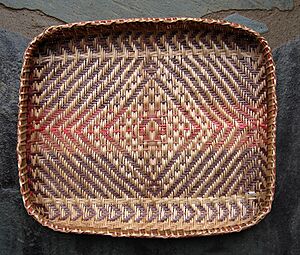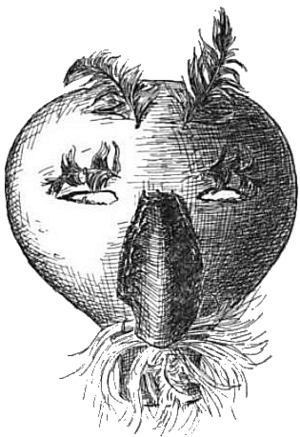Cherokee society facts for kids

Cherokee society is all about the way the Cherokee people live, their traditions, and how their communities are set up. In their own language, it's called aniyvwiyai (ᎠᏂᏴᏫᏯᎢ). The Cherokee are Indigenous people who originally lived in the mountains and inland areas of the southeastern United States. This includes parts of what are now North Carolina, South Carolina, Tennessee, Virginia, and Georgia. Sadly, in the 1830s, most of the tribe was forced to move to Indian Territory in Oklahoma.
Today, there are three main Cherokee tribes that the U.S. government officially recognizes. These are the Cherokee Nation of Oklahoma, the United Keetoowah Band of Cherokee Indians (also in Oklahoma), and the Eastern Band of Cherokee Indians. The Eastern Band includes the Cherokee people who stayed in North Carolina.
Contents
The Three Tribes Today
The Eastern Band of Cherokee Indians has its main offices in Cherokee, North Carolina. This area is known as the Qualla Boundary. The Cherokee Nation and the United Keetoowah Band of Cherokee Indians are both based in Tahlequah, Oklahoma. Their ancestors settled here after being moved from their homelands in the 1830s.
There's a local story about how Tahlequah got its name. It says that after the Cherokee arrived there on the Trail of Tears, three elders planned to meet. They wanted to pick a spot for their tribal government. Two elders arrived and waited for the third. When it got dark, they decided "two is enough" (Ta'ligwu). In Cherokee, "Ta'li" means "two" and "gwu" means "it's enough." So, "Two is enough." This story likely started in the 1930s. Other ideas for the name's origin include an old eastern Cherokee town called Great Tellico, or a word meaning "plains."
Seven Cherokee Clans
Cherokee society has always been organized around seven special groups called clans. Each clan had important roles in the community.
These are the seven clans:
- Blue (also Panther or Wild Cat) Clan (ᎠᏂᏌᎰᏂ (a-ni-sa-ho-ni) in Cherokee)
- Long Hair (also Twister, Hair Hanging Down, or Wind) Clan (ᎠᏂᎩᎶᎯ (ah-ni-gi-lo-hi) in Cherokee). Members of this clan were known for their fancy hairstyles and proud way of walking. The Peace Chief often came from this clan.
- Bird Clan (ᎠᏂᏥᏍᏆ (a-ni-tsi-s-qua) in Cherokee)
- Paint Clan (ᎠᏂᏬᏗ (a-ni-wo-di) in Cherokee). This clan was known for making red paint.
- Deer Clan (ᎠᏂᎠᏫ (a-ni-a-wi) in Cherokee). They were known as fast runners and skilled hunters.
- Wild Potato (also Bear, Raccoon, or Blind Savannah) Clan (ᎠᏂᎦᏙᎨᏫ (a-ni-ga-do-ge-wi) in Cherokee). They gathered wild potatoes for food from swampy areas near streams.
- Wolf Clan (ᎠᏂᏩᏯ (a-ni-wa-ya) in Cherokee). This was the largest and most important clan. Many of the tribe's war chiefs came from this clan.
Clans did many important things. They took care of orphans and people who needed help. They also offered a warm welcome to clan members visiting from other towns. This practice was called Gadugi (ᎦᏚᎩ) long ago.
Villages and Government

Each Cherokee village had two types of government: a white government and a red government. The white government was mainly in charge during the spring planting season. It handled everyday matters and peace. Both men and women could be chiefs in this government. In the fall, which was seen as the time for war, the red government took over.
White Government (Peace Time)
The white government included the Peace Chief, an advisor, and important counselors (one from each clan). There was also a council of elders, a chief speaker, messengers, and officers for ceremonies. This group made decisions for the tribe during peaceful times, dealing with community issues and ceremonies.
Red Government (War Time)
The red government had a Great War Chief, the Great War Chief's Second, seven War Counselors, and a War Woman (also called "Beloved Woman"). It also included the Chief War Speaker, Messengers, Ceremonial Officers, and War Scouts. The seven war counselors decided if war was needed. The War Woman and Grandmother Elders would decide what happened to captives or prisoners taken during wartime.
Council House
Cherokee towns had a large meeting place called a Council House, or ga-tu-yi (ᎦᏚᏱ). This building was the center of government for each town. It had seven sides, which created seven sections. This way, each clan had its own place for its representatives within the government structure. The seven sections of seats were arranged around a sacred fire. Weddings and other important meetings were also held in the Council House.
Family Life
Traditionally, Cherokee society is matrilineal. This means that property and social status have historically passed down through the women in the family. For traditional Cherokee people, a child is considered part of their mother's family and clan. The most important man in a child's life is often their mother's oldest brother.
Naming Traditions
A person's name given at birth might change later in life. This would happen to mark important events or stages. For example, someone might earn a new name after doing something amazing, or after reaching puberty.
Justice System
In the past, the Cherokee had a system of justice that involved the victim's clan.
In 1808, the Cherokee people created the Lighthorsemen. These were the main law enforcement officers for the Nation. They were later reorganized in 1817. By 1825, the Lighthorsemen were replaced by Marshals, Sheriffs, and Constables. This change happened because people wanted a more structured law enforcement system, similar to what was used by European-Americans.
Cherokee Ceremonies
The Cherokee celebrate seven main ceremonies, along with smaller related ceremonies. These are:
- New Moon Festival (First Festival)
- Green Corn Ceremony (Second Festival)
- Ripe Corn Ceremony (Third Festival)
- Great New Moon Ceremony (Fourth Festival)
- Friends Made Ceremony (Fifth Festival, also called Propitiation Festival)
- Bounding Bush Ceremony (Sixth Festival)
- Uku or Ookah Dance (This dance is only performed every 7 years).
Traditional Dances
Traditional Cherokee people have both social dances and ceremonial dances. Some dances that still exist today might be performed for different reasons than they were long ago. Like many cultures, the Cherokee have also been influenced by their neighbors.
Cherokee Dances include the Booger Dance, Stomp Dance, War Dance, a victory dance called the Eagle Tail Dance, Ant Dance, Bear Dance, Beaver Hunting Dance, Friendship Dance, Forest Buffalo Dance, and Uka Dance.
Using Masks in Dances
Some Cherokee traditional dances use masks. The masks for the Booger Dance show different faces of the enemies of the Cherokee. These masks can be made from large gourds, hornets' nests, buckeye wood, or poplar wood. Masks inspired by traditional Booger Masks are now often made and sold to tourists.
The Bear Dance, Beaver Dance, and Forest Buffalo Dances may also use masks.



